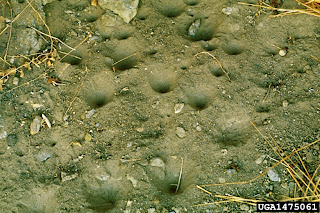Antlion larva (Photo: Alex Wild, http://www.alexanderwild.com) |
Antlions are quite fierce and scary looking. One look and you know you're dealing with a voracious predator (see photo above)! The antlion digs a pit in sand or other loose soil and hides beneath the sand at the bottom of the pit. When an ant or another small insect comes by, it falls into the pit where it slips to the bottom and is grabbed and made into a meal by the antlion. If the prey attempts to scramble up the walls of the pit, the antlion throws loose sand from below. This causes the sides of the pit to collapse, bringing the prey down into the bottom of the pit.
Check out this awesome video to see an antlion in action: http://www.youtube.com/watch?v=7lYAWwMOCXE
Adult antlion (Photo: Joseph Berger, Bugwood.org) |
Antlions are commonly referred to as doodlebugs because they leave lines in the sand that resemble "scribbling" or "doodling" as they meander through the sand searching for the perfect place to make their pit. Check out the video below to see an antlion "doodling."
Antlion pits (Photo: Whitney Cranshaw, CSU) |
You can easily observe antlion behavior in nature. If you ever run across an antlion pit (see photo above), you can use a small blade of grass to brush the sides of the pit. This will usually cause the antlion to flick sand up in the pit. You can also capture an antlion by carefully scooping out the entire pit (using your hand or a cup), being careful to dig deep and wide enough so the antlion isn't crushed. Pour the sand through a strainer until you see the exposed antlion.
The antlion is a great insect to keep and observe in the classroom if you are willing to provide live insects for it to feed on. You can catch ants or other small insects to feed your antlion. You can also purchase wingless fruit flies online - they make a great food source for antlions. You can either collect an antlion as described above or you can buy them online. You'll need a small container with sand to house your antlion in. Provide your antlion live insects twice a day and lightly mist the container with water every other day.





No comments:
Post a Comment